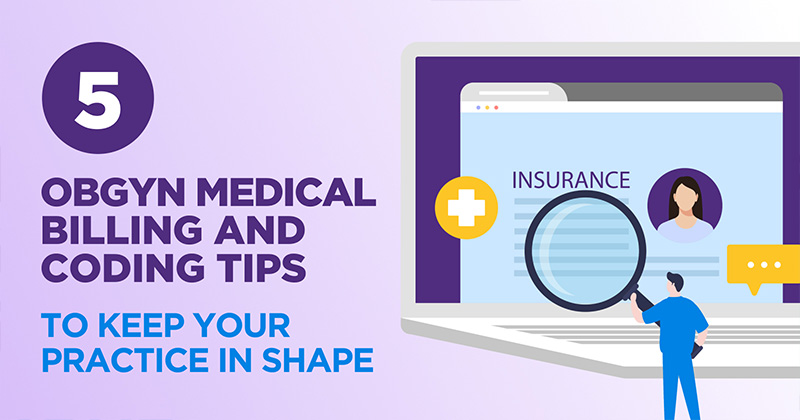5 OBGYN Medical Billing and Coding Tips to Keep Your Practice in Shape

OBGYN medical billing tips to help your practice succeed
Published August 12, 2022.
You spend your time providing the best OBGYN care possible for your patients. But when was the last time you thought about checking up on your practice’s financial health? Here are five tips to encourage timely payments, streamline processes, and speed up reimbursements to help you keep your practice as healthy as you strive to keep your patients.
Tip #1: Communicate Patient Financial Responsibility Clearly
You can make it easier for patients to understand the cost of their gynecological and obstetric services by providing a clear financial policy as part of your check-in process. Most patients will probably appreciate knowing your co-payment collections process, cancellation and no-show policies, and how your office handles insurance claims upfront to avoid any surprises or confusion later.
Additionally, with the new hospital requirements from CMS that are moving the needle towards greater price transparency throughout the healthcare industry, your office can leverage this trend to its advantage. Providing a cost estimate for services up front can help self-pay and underinsured patients budget and plan ahead for medical bills since they have a better idea of what to expect. Timely insurance verification is key to determining a more accurate cost estimate.1
Learn how ModMedⓇ’s Practice Management solution can help with insurance verification and cost estimates.
Tip #2: Avoid Common Coding Errors
Sometimes providers overlook adding codes for problems that present and are addressed during a prenatal or gynecological visit that could be billed for separately at the time of service if allowed by the payer. For example, a patient comes in for a routine prenatal visit. They complain of pain during urination, and following an exam, you diagnose a case of bacterial vaginosis.
Beyond prenatal codes, you may be eligible to code for ICD-10: N76.0 (Acute vaginitis), as well as CPT: 99213 (office or other outpatient visit for the evaluation and management of an established patient), which requires a medically appropriate history and/or examination and low level of medical decision making or 20-29 minutes of total time spent on the date of the encounter.2
Another common area where coding issues can arise is when a patient desires a vaginal birth following a cesarean section. Many providers select CPT: 59400: routine obstetric care including antepartum care, vaginal delivery (with or without episiotomy, and/or forceps) and postpartum care. However, the more accurate selection would be CPT: 59610, which includes “after previous cesarean delivery.”
Small mistakes like these can lead to lower reimbursement rates, so it’s important to keep current on best coding practices. It’s also important to keep current on well woman billing codes and obstetrics billing guidelines. Keep useful billing code references readily accessible, such as CPT code range 99381 – 99387 for preventative services to help code annual gynecological exams.
The American College of Obstetrics & Gynecologists offers a comprehensive coding resource library to help you and your staff keep current on best coding practices, including ICD-10-CM codes for gynecology and obstetrics.
And ModMed’s EHR system, EMAⓇ, includes an automated suggested coding function that scans the full list of ICD-10 codes for OBGYN. It suggests codes based on your clinical documentation, making final review and sign-off easier for providers.
Tip #3: Improve Claims Scrubbing Before Submission
Clean claims are essential for timely reimbursements from insurance payers. When a claim is denied, the coding is often the first area that’s scrutinized when it comes back to the office. But there are many other reasons a claim could be denied that can be much harder to spot.
Incorrect patient demographic information can cause a denial. Since there’s a high level of focus on the patient’s information, it’s possible that the provider’s information is inaccurate and could be overlooked. Submitting a claim outside of the claims submission period for a payer can also lead to problems.3 Billers need to pay close attention to the details on the claim to make sure that it’s clean.
Searching through rows and rows of data to find inaccuracies slows down your collections process. It also wastes time that your billing staff could be spending working on higher level priorities. ModMed’s Practice Management system helps your staff review claims with a clearinghouse interface, customizable scrub rules and automated claim file submission.
Tip #4: Generate Clear Statements and Bills
In the gynecology and obstetrics space, diagnostic testing and screening is considered a routine part of many types of visits. But that doesn’t mean the patient understands that a urinalysis or an ultrasound will be a separate charge. In some cases, patient bills go unpaid because there’s confusion about what insurance will cover. Patients might even assume a bill is a mistake.
Communicating patient financial responsibility at the beginning of a visit, as described in Tip #1, can help with heading off this problem. Generate a final bill that includes the patient’s insurance, deductibles and third-party charges for pathology or imaging so that the patient understands exactly what they’re paying for and why.4 Posting this bill to an online Patient Portal reassures patients that they can securely contact your office with any questions about their bill, examine their bill in a timely fashion, and pay their balance all in one place.
Tip #5: Provide Options for Patient Payments
It’s simple—the more options patients have to pay their bills, the more likely your practice is to collect what you’re owed. Patients are used to paying for goods and services on their phones, computers and tablets. Your practice can take advantage of how patients already prefer to pay by offering multiple options.
Beyond paying by mail or phone, your practice can collect payments at the front desk with a credit card terminal, or via your online patient portal. ModMed Kiosk offers another option for payment at check-in, and ModMed Pay empowers your office to collect balances with text-to-pay and online quick pay. It also provides payment plan and autopay options.
ModMed Pay allows you to automate the processing of payments according to agreements that you have reached with patients so your coordinator doesn’t have to focus on processing and collecting payments. We automatically process the credit card based on the amount and schedule you enter in Pay, reflecting your agreement with the patient and taking the human factor out of scheduled card processing.
Follow these tips to polish up your billing and coding practices and you’ll be well on your way to carrying your practice to a healthier place.
References
1. Jacqueline LaPointe, “Top Ways to Improve Collection of Patient Financial Responsibility,” revcycleintelligence.com (2020 September 18)
2. Monica Walker, “Correct Common OB/GYN Coding Mistakes,” American Academy of Professional Coders (2019 June 10)
3. “What are the most common errors when submitting claims?” medicalbillersandcoders.com (2021 June 23)
4. Patricia Chaney, “Medical Billing and Cost Considerations for Gynecology and Fertility Practices,” Empowered Women’s Health, General Electric Company (2022 March 19)
This blog is intended for informational purposes only and does not constitute legal or medical advice. Please consult with your legal counsel and other qualified advisors to ensure compliance with applicable laws, regulations and standards.
Learn more about our OBGYN software suite
Get Social With Us
Featured Posts
Topics


